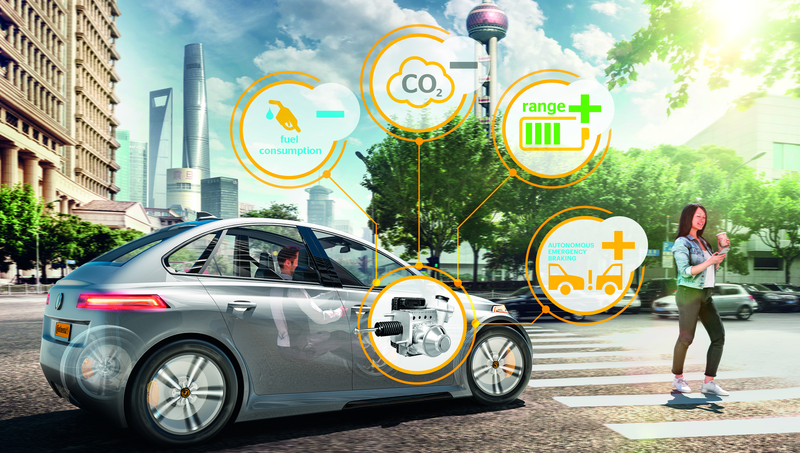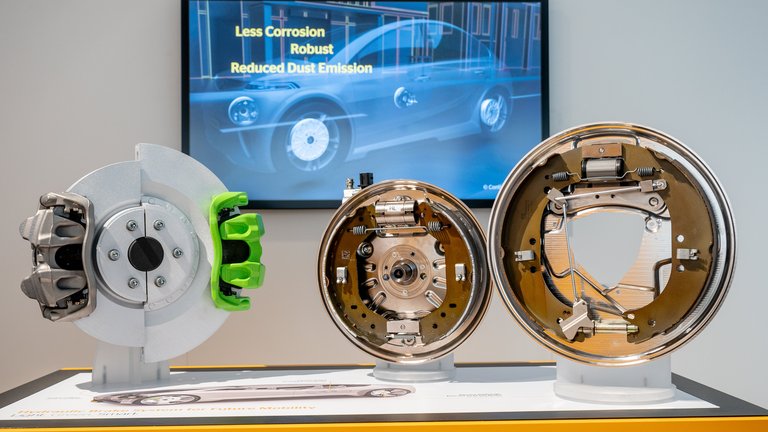Vision of Crash-Free Driving: Continental Drives the Development of Innovative Safety Systems Forward
TechShow Around the World 2021
- Driver assistance, braking systems, more safety – the goal is "Vision Zero"
- New technologies and connected systems for maximum road safety
- Continental's "SensePlanAct" system approach as the basis for safe and autonomous vehicles
Frankfurt, Germany, October 2021. Cameras, radar sensors and lidars keep an eye on the area around the vehicle. The next generation of the one-box brake-by-wire brake system, the MK C2, builds up the required brake pressure three times faster than the previous systems and can therefore react quickly and safely to different driving situations. For Continental, it also provides the basis for future brake systems. The lightweight “Green” Brake Caliper offers high braking performance with lower weight and significantly reduced residual brake torque – with the potential to save up to two grams of CO2 per vehicle. If an accident is unavoidable, the intelligent airbag control ensures that the airbag is deployed according to the occupants and the impact.
These are just a few examples of Continental's safety technologies that will make driving even safer in the future – and that will be shown at the TechShow. By the way, it's not just about driving a car: Continental also offers a range of innovative assistance systems for motorcycles under the acronym ARAS (Advanced Rider Assistance Systems), including a lane change and blind spot assistant, intelligent adaptive cruise control and an emergency braking assistant with a collision warning system.
All of these safety technologies make it possible to get closer and closer to "Vision Zero", i.e. crash-free road traffic, through progressive connectivity and new software functions. "Continental is a system supplier with a comprehensive understanding of driving safety. In order to get closer to the goal of crash-free driving, we combine know-how from a wide variety of areas – from sensor technology to control units, from hardware applications to software expertise," says Dr. Hans-Jörg Feigel, Head of Strategy & Future Solutions in the Autonomous Mobility and Safety business unit at Continental. "Our system approach for the 'SensePlanAct' chain of effects – recognizing, evaluating and responding to critical situations of all kinds – makes this holistic approach to our security technologies clear."
New safety systems are crucial for the road traffic of the future
The importance of technologies that make driving safer will continue to increase in the future. Despite all efforts to date, more than 1.3 million people are killed in road traffic accidents every year, and a further 50 million people suffer injuries. These figures alone show how important innovative technology solutions are to ensure the safest possible vehicles and roads. At the same time, the pursuit of maximum safety vehicles also holds enormous business potential: The global market for safety systems in vehicles currently has a volume of around 32.4 billion euros. According to forecasts, this volume is expected to be 47 billion euros by 2030.
In the area of vehicle safety in particular, Continental can build on decades of experience and extensive expertise in all relevant technology fields. The company's brake systems and cameras, radar sensors and control units are used millions of times worldwide – and they are constantly being developed further. The next generation of the brake-by-wire brake system, the MK C2, was made to weigh around 30 percent less. At the same time, recuperation efficiency has been increased by around 30 percent compared to conventional hybrid brake systems, which in turn reduces CO2 emissions by up to five grams per kilometer. For Continental, it also provides the basis for future brake systems. The evolution towards integrated motion control systems and dry brakes is already in full swing at Continental.
When it comes to innovations for future sustainability and clean braking requirements, both disc and drum brakes offer specific potential for future brake systems. Depending on the vehicle class and strategy of the automobile manufacturer, both types of wheel brakes will also be required in the future. Due to their design, drum brakes offer advantages in terms of robustness regarding corrosion and particle emission. The high-performance disc brakes can be developed to an appropriate level through secondary measures. For this reason, Continental is proactively advancing both technologies with the “green” brake caliper, the drum brakes in simplex and duo-servo designs in order to offer the best compromise between braking performance, costs, sustainability and efficiency for every type of vehicle.
Intelligent airbag control unit helps to reduce the risk of injury
The latest example is the stronger connectivity of the two perspectives around the vehicle and in the vehicle under the motto "Allround Protection". At the heart of this is the airbag control unit. Over the past 35 years, Continental has already delivered more than 350 million such control units. Based on this experience, new functions are now being integrated: In the future, the airbag control unit will receive information about the vehicle's surroundings and the position of the occupants in the interior.
Thus, in the event of an impact, the deployment of the individual airbags in the vehicle can be precisely adapted to the respective situation. For example, the airbags can deploy earlier or more gently. The inflation of the airbags can be controlled according to the situation, thanks to a new valve technology from Continental. The time period during which the airbag remains inflated can also be regulated as required. The highly developed airbag control unit, supported by crash sensors placed at strategic points in the vehicle, reacts optimally to an impact within milliseconds. And this, in turn, can significantly reduce the risk of injury to the occupants.
Cabin Sensing: Innovative system solution protects children in the vehicle
At the TechShow, key functions for interior monitoring can be experienced in a demonstration vehicle. The Cabin Sensing system solution, for example, takes the principle of driver monitoring to a new level: Camera data is combined with radar sensors and intelligent software to reliably and in real time record adults, children, animals and objects in the vehicle. The system warns, for example, if children are left alone in a parking car. The "virtual passenger" will also be in use in the demonstration vehicle.
Connectivity increases safety and is a prerequisite for autonomous driving functions
Continental is not only constantly developing the individual safety components but is also driving their connectivity forward. In the future, active and passive safety systems will become integrated safety systems, because the sensor data of the vehicle will not only be precisely valued but also linked more closely. This increases driving safety, is another step towards "Vision Zero" and also an essential prerequisite for future automated vehicles.

Sören Pinkow
Media Spokesperson Autonomous Mobility and Commercial Vehicles
Continental Automotive






